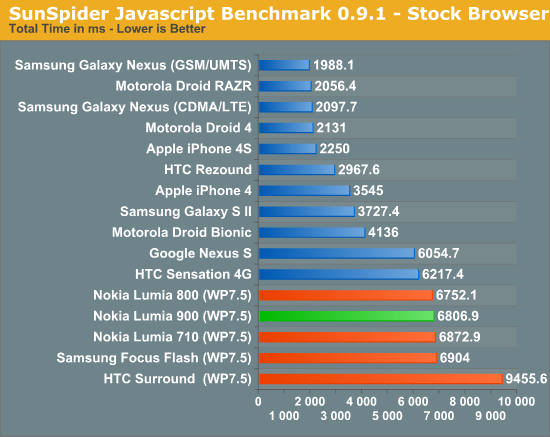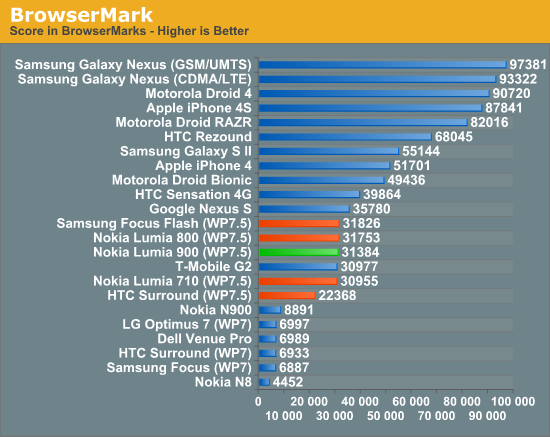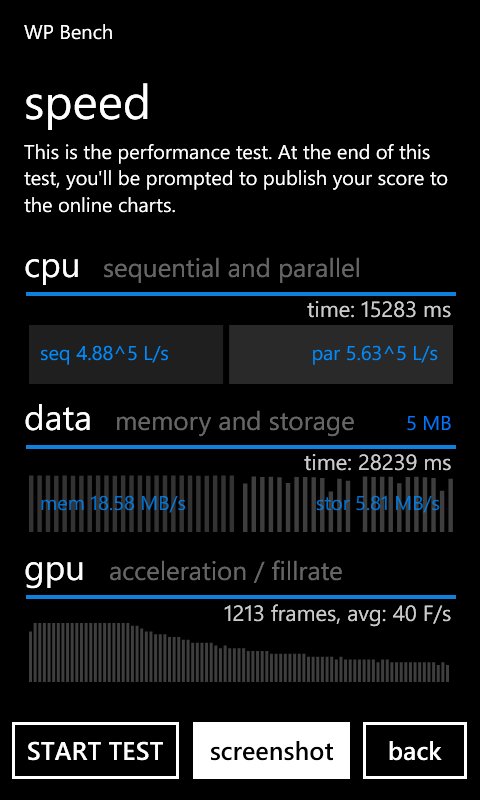Nokia Lumia 900 Review - Windows Phone with LTE
by Brian Klug on April 3, 2012 9:00 PM ESTPerformance
Performance on Windows Phone 7.5 at the moment tops out at almost the same place for virtually every handset. As I touched on before, the platform is still a Qualcomm-only party, and the name of the game is single core 45nm Snapdragon with Adreno 205 at the high end in the form of either MSM8x55, or for the Lumia 900 APQ8055 at 1.4 GHz.
I’ve already penned some thoughts on WP7’s current chassis spec, and in the future the specification will open up with the Tango update (which we’ve seen in the Lumia 610) to a lower-end configuration with MSM7x30 or MSM7x27A. Eventually Windows Phone will move onto dual core SoCs and possibly more vendors, but when and how that happens remains to be seen. The driving factors will undoubtably be both performance, but also improvements to things around the edges like 1080p video encode, decode, and power gains from a 28nm process geometry.
For now however let’s focus on the Lumia 900, which again is 1.4 GHz APQ8055 with 512 MB of LPDDR2. Benchmarking WP7.5 still is a pretty basic thing, since platform consistency somewhat obviates the need for many of the other big cross-platform benchmarks (this will change with Windows 8, however). For now that means our testing is limited primarily to assessing javascript performance with sunspider, browsermark, and WP Bench.


At this point all the most modern WP7 devices are still shipping with essentially the same SoC - 1.4 GHz 45nm MSM8x55/APQ8055. For comparison, the initial launch devices were 65nm QSD8x50 at 1 GHz. With the Tango update performance differences will start to be more of a thing for consumers to care about as it becomes possible to select a phone with a lower end SoC that still runs the Windows Phone UI at a decent clip (like the Lumia 610 we’ve handled). As a result, it isn't surprising at all to see the WP7.5 devices with the same exact SoC all clumped together and performing basically the same. In addition, though the WP7.5 IE JavaScript engine (Chakra) is a huge improvement upon the WP7 JScript engine, it still lags behind the competition on Android and iOS.














128 Comments
View All Comments
tipoo - Wednesday, April 4, 2012 - link
It seems to me like Microsoft is deliberately capping WP7 phones so that Apollo phones will look even better by comparison, with the SoC single core limitations and screen resolution caps. I wonder if this phone or other WP7 phones will be able to get WP8 then, or if that will only be on dual core phones?melgross - Wednesday, April 4, 2012 - link
The OS can't handle multi cores or a higher Rez. That's just the way it is. Since that's going to limit sales, why would they deliberately want to do that?Yes, there's a fork of CE (which is what WP7 uses), which allows dual cores, but it has it's own problems as a phone OS.
tipoo - Wednesday, April 4, 2012 - link
But I'm still wondering if current phones will be able to get WP8. Since it has a new kernel, my guess would be no.N4g4rok - Wednesday, April 4, 2012 - link
It's possible, but my not be a profitable. There's always that ugly little trade off between going next generation or supporting legacy hardware.I think what they do with it will depend on how different the OS itself is in terms of features and UI. If it brings an entirely new suite of capabilities that would not be as efficient on single-core platforms, then it might not hurt to let the previous generation to go to pasture. Otherwise, they might loose that regard as an efficient handset.
Then again, who knows if the kernel in Apollo will be built with the intension to utilize dual core hardware, or if the upgraded hardware will be mainly for drawing attention from developers.
Braumin - Wednesday, April 4, 2012 - link
I don't think the kernel will matter. The new kernel will support far more hardware than the old one.When you upgrade your PC from Windows XP to Windows 7, the kernel changes, but the hardware doesn't.
I assume that since basically there are only a couple of different hardware specs for WP7, they will make it possible. The question of course is whether the hardware vendor will bother with the upgrade. In most cases, I would say no, but I also think Nokia will be the exception.
We'll see in the fall though!
ol1bit - Wednesday, April 4, 2012 - link
Yea, Microsoft is way behind in the phone game. They need to keep up, how long have they been play with WP7 now, and still no high rez or multi-core?I think MS continues to make bad decisions. Who wanted a single threaded OS 3 years ago? They just looked at Apple current and said we like that, and lets design ours just like that.
Goggle looks to the future and started Android out multi-threaded. I hope Alppol isn't a hack job with fake multi-threading added in.
robco - Wednesday, April 4, 2012 - link
The $99 price point is interesting, same as the iPhone 4, but with more storage and LTE. I suppose that works since they're still behind the 4S a bit.I like WP7 and if I decide to ditch iOS, it would be my next choice. I just hope MS will support more chipsets and higher display resolutions sooner rather than later. Of course the big issue for me, and others in this area, is the carrier issue in the US. I won't go back to AT&T. For many people the reception is fine and the service tolerable, but not where I live. So far the only WP7 handsets on Sprint or VZW are even more dated.
MS has a lot of ground to gain, but it's not as if they don't have the resources to throw at it...
NeoteriX - Wednesday, April 4, 2012 - link
Brian,Your insight into the display, and in particular, digging up the optical path of the ClearBlack technology, may be overlooked by many. But it's really something where your obvious optics education/background gives you and AnandTech significant added value over the droves of blathering nontechnical review sites and blogs.
Kudos.
EddyKilowatt - Wednesday, April 4, 2012 - link
If this is the kudos section, let me award one too, for posting and discussing the MediaInfo screencap showing the video and audio codec settings. That too is the kind of non-blathering, solid tech info that I'm glad you guys specialize in.(I actually googled "lumia 900 video bitrate"... and must confess I grinned a knowing grin when I saw AnandTech pop up in the first screen of hits.)
name99 - Wednesday, April 4, 2012 - link
"Interestingly enough Nokia does note the presence of Rx diversity for WCDMA on the Lumia 900 front and center, both under their “design” tab and under Data Network on the specifications page. It’s awesome to see another handset vendor realize that great cellular performance is noteworthy"I'm rather more cynical than you. Note that they do NOT support HSPA MIMO.
My guess is that at least part of talking up their diversity antenna is specifically to deflect from that --- throw out some techno-lingo about how we have multiple antennas to "maximize RF performance" and hope no-one notices some conspicuous holes in our HSPA features.